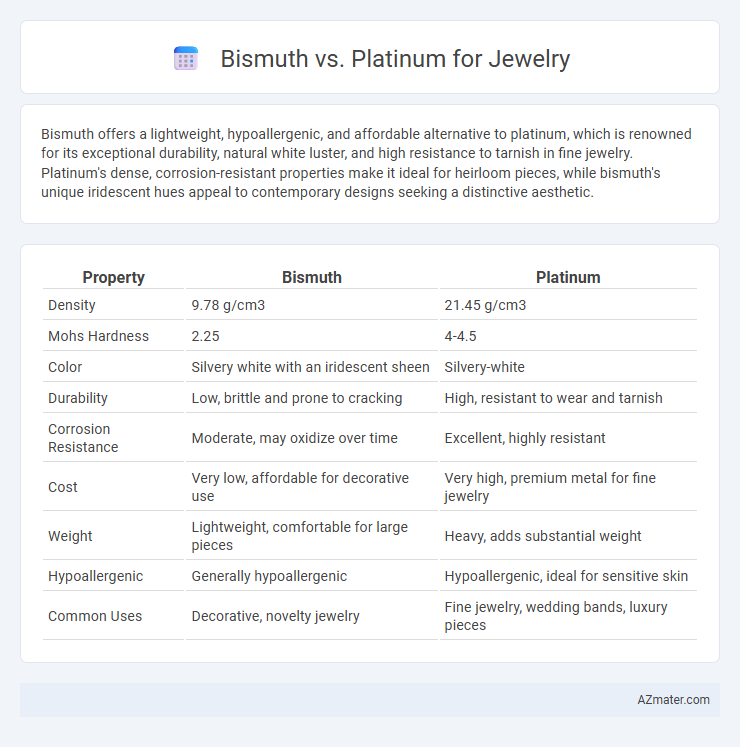Bismuth offers a lightweight, hypoallergenic, and affordable alternative to platinum, which is renowned for its exceptional durability, natural white luster, and high resistance to tarnish in fine jewelry. Platinum's dense, corrosion-resistant properties make it ideal for heirloom pieces, while bismuth's unique iridescent hues appeal to contemporary designs seeking a distinctive aesthetic.
Table of Comparison
| Property | Bismuth | Platinum |
|---|---|---|
| Density | 9.78 g/cm3 | 21.45 g/cm3 |
| Mohs Hardness | 2.25 | 4-4.5 |
| Color | Silvery white with an iridescent sheen | Silvery-white |
| Durability | Low, brittle and prone to cracking | High, resistant to wear and tarnish |
| Corrosion Resistance | Moderate, may oxidize over time | Excellent, highly resistant |
| Cost | Very low, affordable for decorative use | Very high, premium metal for fine jewelry |
| Weight | Lightweight, comfortable for large pieces | Heavy, adds substantial weight |
| Hypoallergenic | Generally hypoallergenic | Hypoallergenic, ideal for sensitive skin |
| Common Uses | Decorative, novelty jewelry | Fine jewelry, wedding bands, luxury pieces |
Introduction: Bismuth vs Platinum in Jewelry
Bismuth and platinum present distinct choices in jewelry due to their unique properties and market value. Bismuth offers vibrant, iridescent colors and is a lightweight, non-toxic metal often favored for artistic and affordable pieces. Platinum, renowned for its durability, rarity, and hypoallergenic qualities, remains a premium option preferred for fine jewelry and investment-grade pieces.
Physical Properties: Bismuth and Platinum Compared
Bismuth has a low density of 9.78 g/cm3, making it significantly lighter than platinum, which has a density of 21.45 g/cm3, ideal for heavier, more durable jewelry pieces. Platinum boasts a higher melting point of 1,768degC compared to bismuth's 271degC, resulting in superior heat resistance and longevity for fine jewelry applications. The hardness of platinum, rated around 4-4.5 on the Mohs scale, surpasses bismuth's brittleness, providing enhanced scratch resistance and structural integrity.
Durability and Wear Resistance
Bismuth is a brittle metal with low durability, making it unsuitable for jewelry subject to daily wear. Platinum offers exceptional wear resistance and maintains its luster over time, significantly outperforming bismuth in durability. Jewelers prefer platinum for high-quality, long-lasting pieces due to its strength and resistance to scratch and tarnish.
Color and Visual Appeal
Bismuth jewelry features iridescent hues ranging from vivid blues and purples to greens and yellows, creating a striking, almost holographic visual appeal due to its unique crystal structure. In contrast, platinum offers a classic, lustrous silver-white sheen prized for its timeless elegance and understated sophistication in fine jewelry. While bismuth captivates with vibrant, eye-catching color variations, platinum remains the benchmark for durability and high-end luxury finishes.
Price Differences: Bismuth vs Platinum
Bismuth jewelry is significantly more affordable than platinum, with bismuth pieces often costing just a fraction of the price due to its abundance and lower production expenses. Platinum, known for its rarity and durability, commands a premium price that can be several times higher per gram compared to bismuth. The price difference stems primarily from the metals' availability, density, and the extensive refining processes required for platinum.
Hypoallergenic Qualities and Skin Safety
Bismuth jewelry is highly valued for its hypoallergenic properties, making it an excellent choice for individuals with sensitive skin or metal allergies. Unlike platinum, which is a precious metal often praised for its durability and resistance to tarnish but can sometimes cause allergic reactions due to alloyed metals, bismuth is naturally non-toxic and rarely induces skin irritation. Its unique crystalline structure and non-reactive nature ensure superior skin safety, positioning bismuth as a safer alternative for hypoallergenic jewelry.
Workability for Jewelers
Bismuth offers exceptional workability for jewelers due to its low melting point of 271.5degC and excellent malleability, enabling easy casting and shaping into intricate designs without requiring high heat. Platinum, with a much higher melting point of 1,768degC, demands specialized tools and significant skill for forging and soldering, making it more challenging to work with but offering superior durability. While bismuth suits experimental and artistic pieces, platinum remains preferred for high-end jewelry where longevity and strength are essential.
Popular Jewelry Types for Each Metal
Bismuth is commonly used in unique, artisanal jewelry such as pendants, rings, and earrings featuring its iridescent, crystalline structures, appealing to those who prefer colorful and unconventional designs. Platinum dominates in luxury jewelry markets, especially for engagement rings, wedding bands, and high-end watches, prized for its durability, hypoallergenic properties, and lustrous, white sheen. Both metals cater to different tastes: bismuth is favored for artistic, statement pieces, while platinum is the standard for classic, timeless elegance.
Environmental and Ethical Considerations
Bismuth is a low-toxicity, abundant element that offers an eco-friendly alternative to platinum, which is rare and requires energy-intensive mining often linked to environmental degradation and unethical labor practices. Platinum mining contributes to habitat destruction and carbon emissions, whereas bismuth's extraction has a smaller ecological footprint and is often derived as a byproduct of other mining processes, reducing waste. Choosing bismuth jewelry supports sustainable sourcing and ethical production standards, making it an environmentally responsible choice compared to the traditional use of platinum in luxury accessories.
Choosing the Right Metal for Your Needs
Bismuth and platinum differ significantly in durability and aesthetic appeal for jewelry, with platinum offering exceptional hardness, resistance to tarnish, and hypoallergenic properties ideal for everyday wear. Bismuth, while affordable and visually striking with its iridescent colors, is much softer and more prone to damage, making it better suited for decorative pieces rather than daily use. Selecting platinum ensures longevity and strength for valuable or frequently worn jewelry, whereas bismuth suits unique, artistic designs where cost and color are priorities over durability.

Infographic: Bismuth vs Platinum for Jewelry
 azmater.com
azmater.com